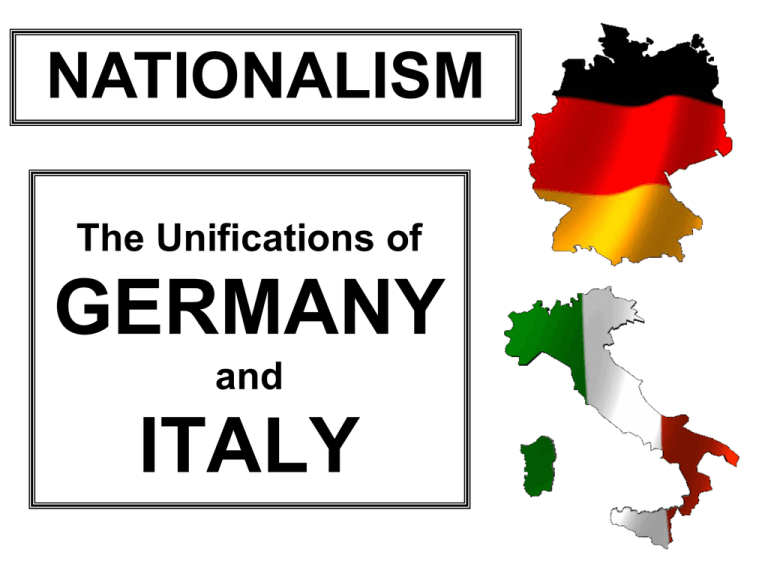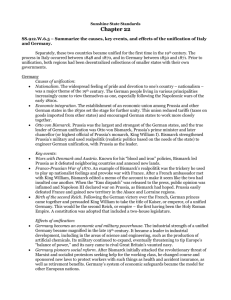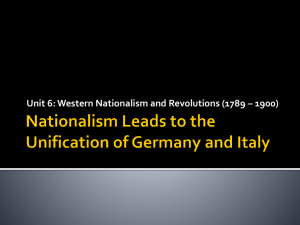Germany
advertisement

NATIONALISM The Unifications of GERMANY and ITALY What is NATIONALISM? Nationalism is loyalty and devotion to a nation of people It is a sense of national identity exalting one nation above all others It can be defined as pride in one’s nation, and it can also be defined as the desire of an ethnic group to have its own country WHAT FORMS A NATION? THESE SIX THINGS ARE WHAT GIVE A GROUP OF PEOPLE IDENTITY AS A NATION-STATE ITALY and GERMANY: TWO DIVIDED NATIONS GERMAN STATES ITALIAN STATES While nations like Spain, Russia, France, and England were UNITED under a single government, the German and Italian people were DIVIDED into numerous small states (Germanic people were found in numerous small states like Prussia, Bavaria, and Hanover) “Italy” in 1815 was not a unified nation; it was divided into three regions Parts were independent and had their own kings Parts were controlled by the Pope Parts were controlled by Austria and France In the 1830s, nationalism led to a unification movement as Italians began to see themselves as having a shared history (ancient Rome, Renaissance), shared territory, shared enemies (Napoleonic Wars) GIUSEPPE MAZZINI Mazzini was a radical who established the nationalist group Young Italy in 1831 with the goal of unifying Italy He led a revolution in 1848, which led to a brief Italian republic (but Italy was not totally unified) Mazzini was overthrown and seen as TOO radical and extreme COUNT CAMILLO DI CAVOUR In 1849, the king of Sardinia named Cavour his Prime Minister Cavour wanted to make Sardinia very powerful by increasing industry and reducing the Pope’s influence COUNT CAMILLO DI CAVOUR He wanted to unify all Italian states, but ONLY if Sardinia led the unification movement Cavour fought wars locally and against Austria (who had claimed parts of Italy) to unite the Northern Italian states under the kingdom of Sardinia GIUSEPPE GARIBALDI Meanwhile, radical nationalists prepared for a revolution in Southern Italy in an effort to unite the southern states GIUSEPPE GARIBALDI Giuseppe Garibaldi was a nationalist who had joined Mazzini’s “Young Italy” and helped in the Latin American independence movements GARIBALDI: AN ITALIAN HERO “Let him who loves his country… follow me.” He wanted a unified Italy under a republic style of government Garibaldi, who always wore a red shirt in battle, named his forces the “Redshirts” ITALY IS UNIFIED Garibaldi successfully led the unification of Southern Italy, while Cavour saw to the unification of Northern Italy; now the goal was to link the two parts together Cavour was unhappy with Garibaldi possibly replacing him as the “unifier of Italy” Cavour does not want a republic; he wants Sardinia’s king in charge of a united Italy Cavour, an experienced politician, convinced the patriotic Garibaldi to give up his southern conquests to Sardinia’s king in the interest of the common good ↕By 1871, Italy’s Northern and Southern halves are unified and a new country under a constitutional monarchy emerges: ITALY GERMANY Germany was the last European country to unify all of its parts into a single nation There had been attempts to unify in the past centuries, but they met with failure GERMANY At one point, Germany had been divided into nearly 200 independent states (all run by various kings and princes who At the time of the Congress of had their little Vienna, 39 Germanic states pieces of were loosely associated (called territory) the German Confederation) PRUSSIA Prussia was the most powerful and influential of the 39 German states Austria was the only other German-speaking nation that rivaled Prussia’s power PRUSSIA Prussia had a great deal of military and industrial power Prussia badly wanted to unify the 39 states into a new nation, Germany PRUSSIA “Prussia was not a country with an army, but an army with a country.” OTTO VON BISMARCK Otto von Bismarck was the Prime Minister of Prussia in the 1860s Bismarck’s goal was the unification of the German states under the leadership of Prussia He led a conservative political party called the Junkers (wealthy landowners) OTTO VON BISMARCK Otto was an advocate of realpolitik: “politics of reality” where there is no room for idealism Bismarck was ruthless and saw using force, threats, and deceit as ways to achieve Prussia’s political goals “BLOOD AND IRON” In 1862, Bismarck makes his intentions known: “Germany will not be united through speeches and diplomacy, but through blood and iron.” “BLOOD AND IRON” The “blood” Bismarck was speaking of referred to people of German blood uniting together and the “iron” referred to the power of Prussia’s industry and military To unite the German states, Bismarck started wars with Denmark, Austria, and France The Franco-Prussian War against France convinces the Catholics in southern Germany that unification with Prussia was better than unification with France Seven Weeks War against Austria led to the North German Confederation (a united northern Germany under Prussia’s control) PRUSSIA IS VICTORIOUS GERMANY IS UNITED By rallying the German people together in these wars, Prussia gains support from all German states for unification under one government In 1871, Wilhelm I (the First) becomes Kaiser (emperor) of the united Germany Otto von Bismarck becomes the Chancellor of Germany Each German state has a local ruler and army and handles its own domestic affairs, but…the Kaiser heads the German national government THE BALANCE OF POWER SHIFTS The balance of power in Europe is disturbed by the sudden emergence of Germany as a military and industrial powerhouse Germany wants what many European countries already have: a rich and powerful empire This competition will eventually lead to the bloodiest, most destructive wars in human history Created by Christopher Jaskowiak
![italiangermanunifi[1]](http://s3.studylib.net/store/data/009628182_1-f43ba01c4570a79b659d367a2bc477b0-300x300.png)

